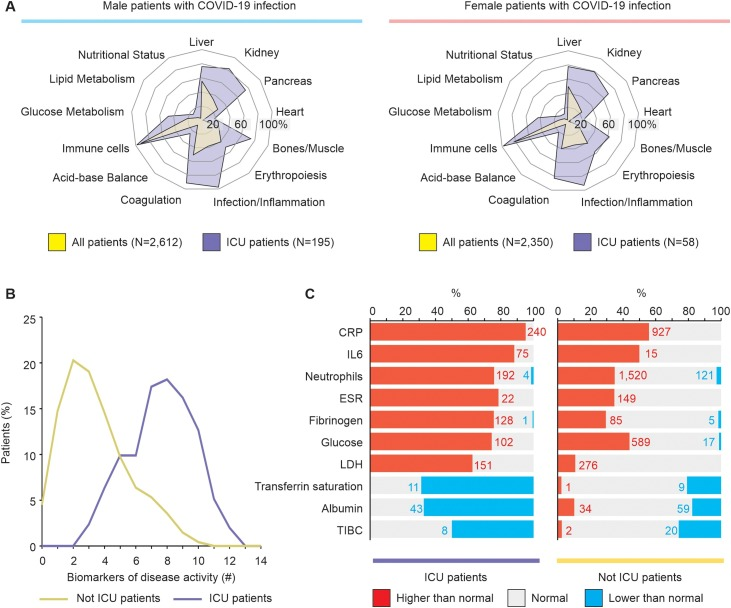In-depth analysis of laboratory parameters reveals the interplay between sex, age, and systemic inflammation in individuals with COVID-19.
The progression and severity of COVID-19 varies significantly in the population. While the hallmarks of SARS-CoV-2 and severe COVID-19 within routine laboratory parameters are emerging, the impact of sex and age on these profiles is still unknown. We performed multidimensional analysis of millions of records of laboratory parameters and diagnostic tests for 178,887 individuals from Brazil, of which 33,266 tested positive for SARS-CoV-2. These included complete blood cell count, electrolytes, metabolites, arterial blood gases, enzymes, hormones, cancer biomarkers, and others. COVID-19 induced similar alterations in laboratory parameters in males and females. CRP and ferritin were increased especially in older men with COVID-19, whereas abnormal liver function tests were common across several age groups, except for young women. Low peripheral blood basophils and eosinophils were more common in the elderly with COVID-19. Both male and female COVID-19 patients admitted to intensive care units displayed alterations in the coagulation system, and higher values of neutrophils, CRP and lactate dehydrogenase. Our study uncovers the laboratory profile of a large cohort of COVID-19 patients that underly discrepancies influenced by aging and biological sex. These profiles directly link COVID-19 disease presentation to an intricate interplay between sex, age and immune activation.
Authors
Felipe Ten-Caten; Patrícia Gonzalez-Dias; Ícaro Castro; Rodrigo L T Ogava; Jeevan Giddaluru; Juan Carlo S Silva; Felipe Martins; André N A Gonçalves; André G Costa-Martins; José D Araujo; Ana Carolina Viegas; Fernando Q Cunha; Sandra Farsky; Fernando A Bozza; Anna S Levin; Pia S Pannaraj; Thushan I de Silva; Paola Minoprio; Fabiano Pinheiro da Silva; Bruno B Andrade; Helder I Nakaya
External link
Publication Year
Publication Journal
Associeted Project
Network & Precision Medicine
Lista de serviços
-
Genomic analyses reveal broad impact of miR-137 on genes associated with malignant transformation and neuronal differentiation in glioblastoma cells.Genomic analyses reveal broad impact of miR-137 on genes associated with malignant transformation and neuronal differentiation in glioblastoma cells.
-
RNA-Binding Protein Musashi1 Is a Central Regulator of Adhesion Pathways in Glioblastoma.RNA-Binding Protein Musashi1 Is a Central Regulator of Adhesion Pathways in Glioblastoma.
-
MicroRNA Transcriptome Profiling in Heart of Trypanosoma cruzi-Infected Mice: Parasitological and Cardiological Outcomes.MicroRNA Transcriptome Profiling in Heart of Trypanosoma cruzi-Infected Mice: Parasitological and Cardiological Outcomes.
-
Genome mapping and expression analyses of human intronic noncoding RNAs reveal tissue-specific patterns and enrichment in genes related to regulation of transcription.Genome mapping and expression analyses of human intronic noncoding RNAs reveal tissue-specific patterns and enrichment in genes related to regulation of transcription.
-
Antimicrobial peptide LL-37 participates in the transcriptional regulation of melanoma cells.Antimicrobial peptide LL-37 participates in the transcriptional regulation of melanoma cells.
-
Down-regulation of 14q32-encoded miRNAs and tumor suppressor role for miR-654-3p in papillary thyroid cancer.Down-regulation of 14q32-encoded miRNAs and tumor suppressor role for miR-654-3p in papillary thyroid cancer.
-
Integration of miRNA and gene expression profiles suggest a role for miRNAs in the pathobiological processes of acute Trypanosoma cruzi infection.Integration of miRNA and gene expression profiles suggest a role for miRNAs in the pathobiological processes of acute Trypanosoma cruzi infection.
-
Integrative Biology Approaches Applied to Human DiseasesIntegrative Biology Approaches Applied to Human Diseases
-
Proteomics reveals disturbances in the immune response and energy metabolism of monocytes from patients with septic shock.Proteomics reveals disturbances in the immune response and energy metabolism of monocytes from patients with septic shock.
-
Genomics, epigenomics and pharmacogenomics of Familial Hypercholesterolemia (FHBGEP): A study protocol.Genomics, epigenomics and pharmacogenomics of Familial Hypercholesterolemia (FHBGEP): A study protocol.
-
Melatonin-Index as a biomarker for predicting the distribution of presymptomatic and asymptomatic SARS-CoV-2 carriersMelatonin-Index as a biomarker for predicting the distribution of presymptomatic and asymptomatic SARS-CoV-2 carriers
-
Profiling plasma-extracellular vesicle proteins and microRNAs in diabetes onset in middle-aged male participants in the ELSA-Brasil study.Profiling plasma-extracellular vesicle proteins and microRNAs in diabetes onset in middle-aged male participants in the ELSA-Brasil study.
-
Big Data and machine learning in cancer theranosticsBig Data and machine learning in cancer theranostics
-
Genomic positional conservation identifies topological anchor point RNAs linked to developmental loci.Genomic positional conservation identifies topological anchor point RNAs linked to developmental loci.
-
Integrative systems immunology uncovers molecular networks of the cell cycle that stratify COVID-19 severityIntegrative systems immunology uncovers molecular networks of the cell cycle that stratify COVID-19 severity

